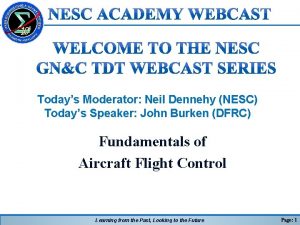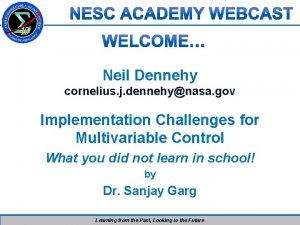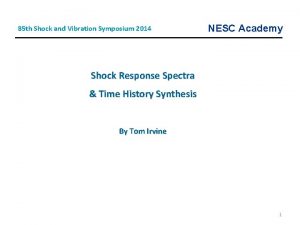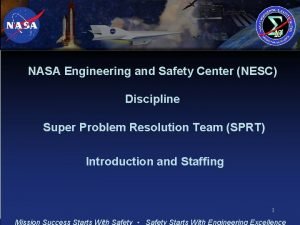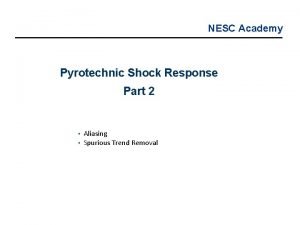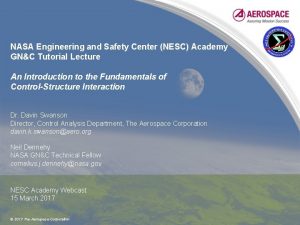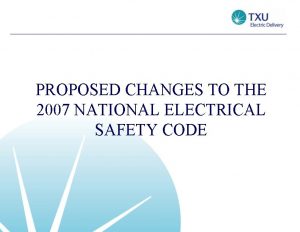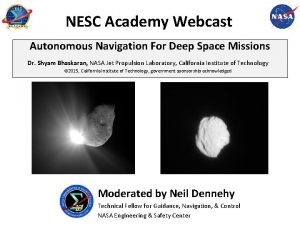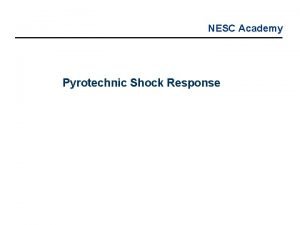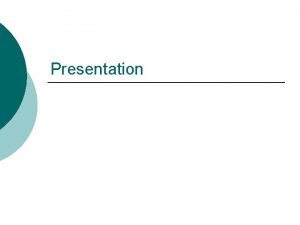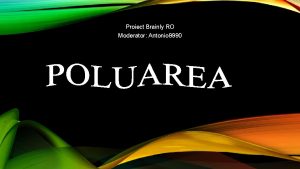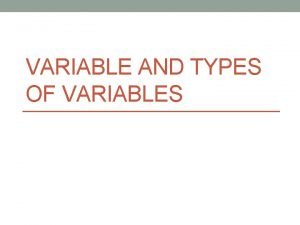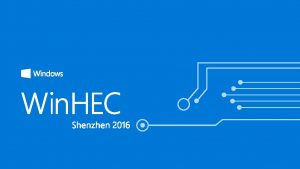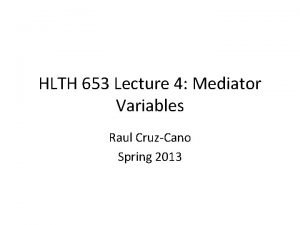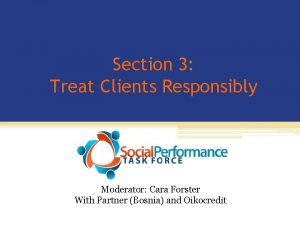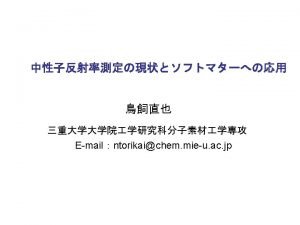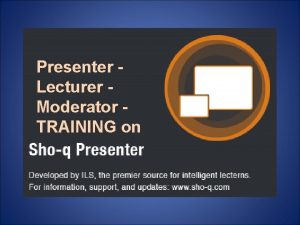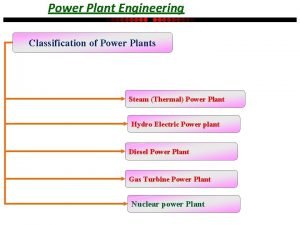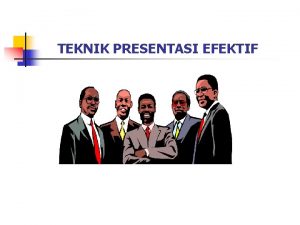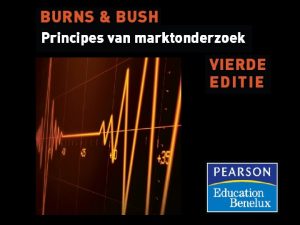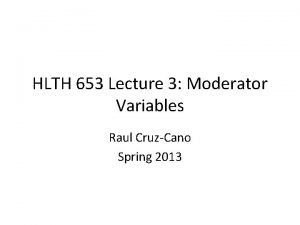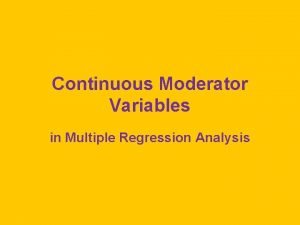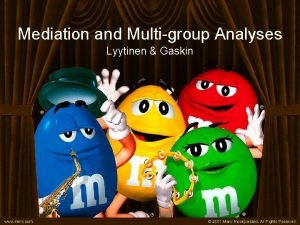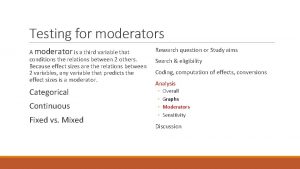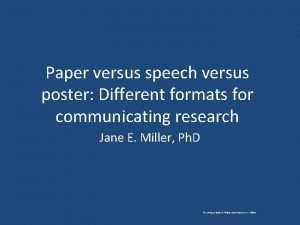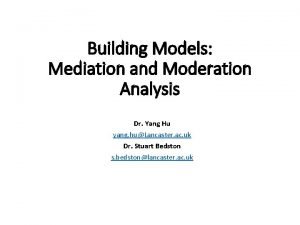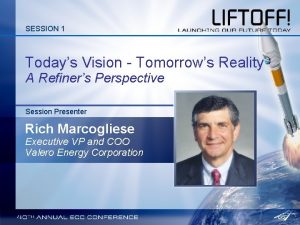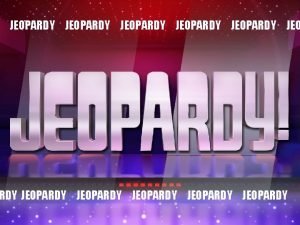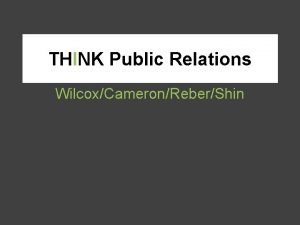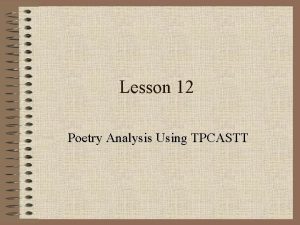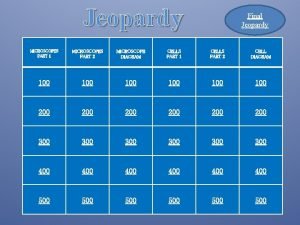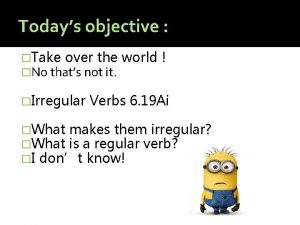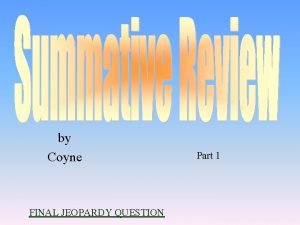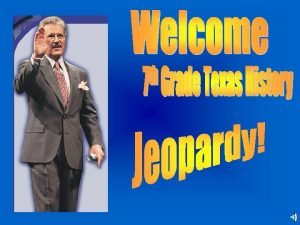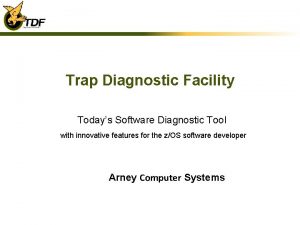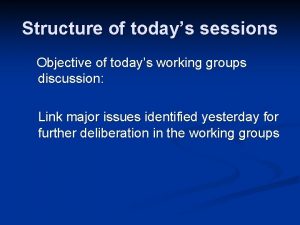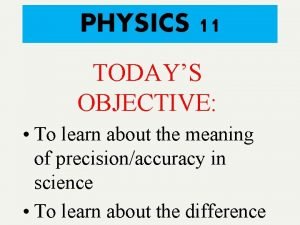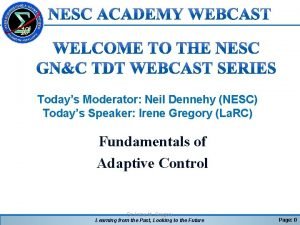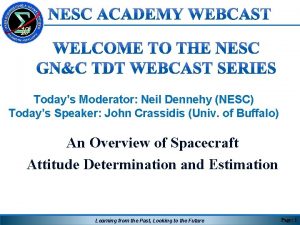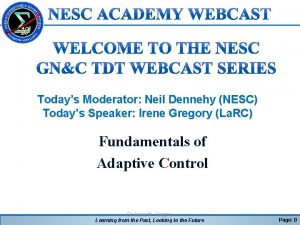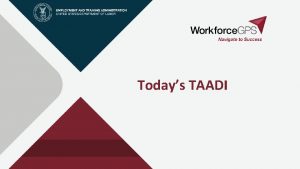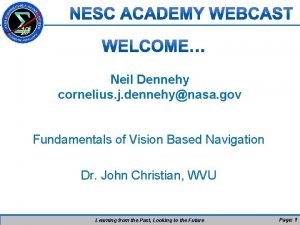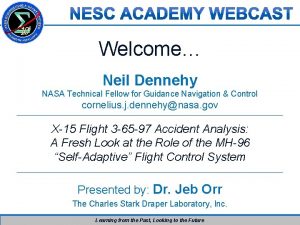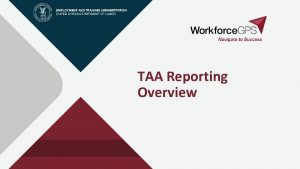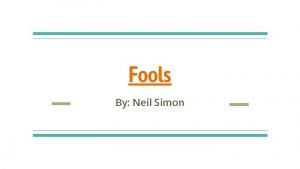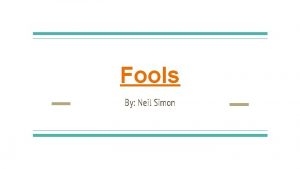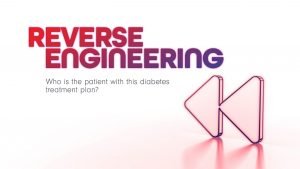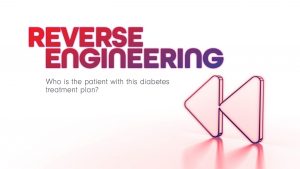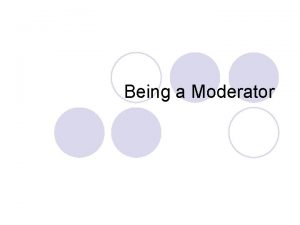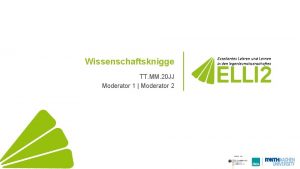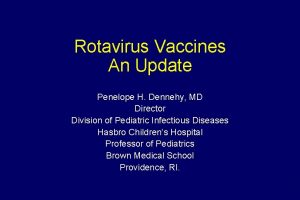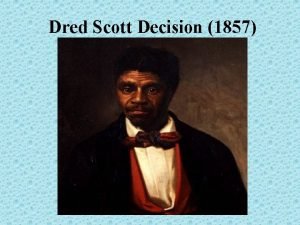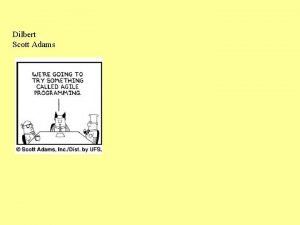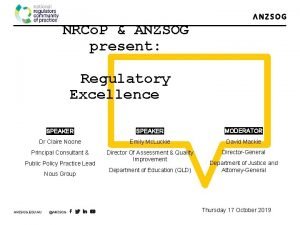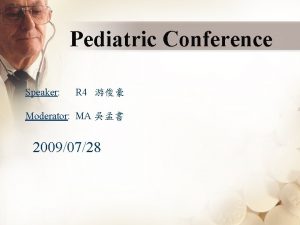Todays Moderator Neil Dennehy NESC Todays Speaker Scott

















































- Slides: 49

Today’s Moderator: Neil Dennehy (NESC) Today’s Speaker: Scott Starin (GSFC) Fundamentals of Spacecraft Attitude Control Next Webcast: Fundamentals of Aircraft Flight Control”, John Burken, (DFRC), on 19 September 2012 NESC GN&C TDT Webcast Series – Fundamentals of Spacecraft Attitude Control, July, 2012 1

NESC GN&C TDT Webcast Series – Fundamentals of Spacecraft Attitude Control, July, 2012 2

Outline § Acknowledgements § Introduction to Spacecraft Attitude Control § Attitude Control System Design − Design Process − Requirements Development − Disturbance Torques and Momentum Management − Attitude Determination − Stabilization Methods − Controller Design and Implementation − Errors and Error Budgets − Flexible-Body Dynamics and Jitter § Examples − Hubble − Solar Dynamics Observatory − ST-5 § Closing and Q&A § Reference Charts NESC GN&C TDT Webcast Series – Fundamentals of Spacecraft Attitude Control, July, 2012 3

Acknowledgements § Jim O’Donnell, David Ward, David Mangus, and Lou Hallock, all of GSFC, have contributed over the years to a University of Maryland lecture on attitude control, from which I have borrowed extensively § Another source of material is the 4 th edition of Larson & Wertz’s Spacecraft Mission Analysis & Design, which in this edition covers much more material and has been titled Spacecraft Mission Engineering: The New SMAD. § Thanks to Alice Liu (GSFC) and Carl Blaurock (Nightsky Systems, Inc. ) for providing slides for discussion of the relationship between jitter and attitude control NESC GN&C TDT Webcast Series – Fundamentals of Spacecraft Attitude Control, July, 2012 4

What is Attitude? § Attitude is the three-dimensional orientation of a vehicle with respect to a reference frame § A telescope on a hill can be tilted higher or lower in − Elevation and − Azimuth § The Earth telescope has two degrees of freedom in pointing and is described fully by a − Unit vector § A telescope in space may rotate around its own boresight − Allows imaging hardware to be aligned optimally with the target § Space missions must, in general, consider 3 DOF in their designs NESC GN&C TDT Webcast Series – Fundamentals of Spacecraft Attitude Control, July, 2012 5

Attitude Control Goals and Reference Frames § Most, but not all, spacecraft missions have some need for pointing one or more pieces of hardware at one or more targets. − Solar arrays must be illuminated, at least partially & for some period of time − Focused antennas must point at targets on the ground or at tracking satellites − Scientific instruments must point at their targets to some level of accuracy − Spinning spacecraft often require the spin axis to lie along a desired direction § A typical goal for a spacecraft attitude control system (ACS) is to point a critical instrument at a target and to point another piece of hardware as close to another target as possible § Choosing the proper reference frame for a given mission is important for mission planning and operations − Communications satellites point their antenna arrays at nadir nearly 100% of their mission, often slowly rotating about nadir to allow their solar arrays to track the Sun: Local Vertical/Local Horizontal (LVLH) reference frame − Astrophysics satellites often maintain a constant attitude relative to the stars, periodically performing attitude maneuvers, called slews, to select new targets: inertial reference frame, such as J 2000. 0 NESC GN&C TDT Webcast Series – Fundamentals of Spacecraft Attitude Control, July, 2012 6

Contrasting Spacecraft and Aircraft Control Y X Z § What is needed to control a vehicle in free-fall outside a dense atmosphere, in contrast to propelling a vehicle through a dense fluid? − Disturbance torques on spacecraft are orders of magnitude less than on aircraft − Free-fall is a neutrally stable condition, whereas air flight is not − Air provides a ready sink for mechanical energy (high damping); spacecraft generally have very low damping of flexible motion § In all, space vehicles can achieve very good pointing accuracy with very lowbandwidth (usu. < 0. 1 Hz) controllers − The lack of damping and low bandwidth mean spacecraft are susceptible to lowamplitude, high-frequency oscillations (“jitter”) that can blur images NESC GN&C TDT Webcast Series – Fundamentals of Spacecraft Attitude Control, July, 2012 7

Diagram of a Complete ACS Image credit: Space Mission Engineering, Microcosm, Inc NESC GN&C TDT Webcast Series – Fundamentals of Spacecraft Attitude Control, July, 2012 8

Top-Level Steps in ACS Design § 1. Define control modes −Define or derive system-level requirements by control mode § 2. Quantify disturbance environment § 3. Select type of spacecraft control by attitude control mode § 4. Select and size ACS hardware § 5. Define determination and control algorithms § 6. Iterate and document NESC GN&C TDT Webcast Series – Fundamentals of Spacecraft Attitude Control, July, 2012 9

Typical Attitude Control Mode Requirements § General pointing requirements. − Define what the “target” is, what needs to be pointed there. Some missions require specific scan patterns or spin rates for their instruments, and these should be known early in formulation. § Pointing accuracy − An allocation of the end-to-end payload pointing budget, which also includes mechanical, thermal, and measurement effects. § Pointing stability (also known as jitter) − Typically derived from instrument resolution requirements, since higher frequency spacecraft motion will blur imagery and degrade resolution. § Attitude determination (or knowledge) − Also an allocation of a larger Observatory budget. Knowledge derives from various mission requirements, including requirements to correctly describe the location of an observation in a sky survey, or as an allocation of a higher-level pointing requirement. § Agility/maneuver requirements − Missions often require special calibration maneuvers or the ability to slew between targets at a certain rate. These requirements tend to drive the controller method and actuators selected. § Acquisition requirements − On missions with solar cells for power generation, the ACS typically has a specific time limit to pointing those arrays at the Sun before battery power runs out. It is important to understand the launch vehicle separation conditions to correctly design for all possible initial conditions. § Safing and reliability requirements − What level of reliability/redundancy should be employed for recovery from anomalies, and what should the ACS do in response to an anomaly? What level of stability is necessary for the reliability needed? NESC GN&C TDT Webcast Series – Fundamentals of Spacecraft Attitude Control, July, 2012 10

Disturbance Environment § External disturbance torques (four main sources) −Solar radiation pressure −Atmospheric drag, or ram pressure −Magnetic torque due to residual dipole −Gravity gradient −May be secular or cyclical § Internal disturbances −Mechanisms: e. g. solar array drive, moving instruments −Thermal snap −Misalignments and quantization in actuators −Propellant motion (i. e. slosh) −Other minor sources: e. g. astronauts (e. g. ISS), outgassing from polymers, differential IR emission NESC GN&C TDT Webcast Series – Fundamentals of Spacecraft Attitude Control, July, 2012 11

§ Solar Radiation Pressure − Constant in given heliocentric orbit § Atmospheric Drag § Magnetic Field § Gravity Gradient NESC GN&C TDT Webcast Series – Fundamentals of Spacecraft Attitude Control, July, 2012 12

Effects of External Disturbance Torques § External disturbance torques add momentum to the satellite § Cyclic: − Average to zero over a circular orbit − Analogous to conservative forces − Aerodynamic, gravity gradient, magnetic torques for inertially-pointed − Magnetic, solar pressure, some gravity gradient torques for nadir-pointed § Secular: − Accumulate over the orbit − Analogous to non-conservative forces − Solar pressure torques for inertiallypointed − Aerodynamic, some gravity gradient torques for nadir-pointed NESC GN&C TDT Webcast Series – Fundamentals of Spacecraft Attitude Control, July, 2012 13

Momentum Management § Disturbance torques add momentum to the satellite § Momentum management − Actuators • Remove (dump) secular momentum change • Magnetic coils • Thrusters • Often a separate control loop run concurrently (especially with magnetics) • Store cyclic momentum change • Reaction wheels must be sized Momentum storage appropriately Momentum storage and attitude control S/C attitude Disturbance torque in inertial frame Disturbance momentum Momentum buildup accumulation in inertial frame Dump momentum Actuator commanded momentum NESC GN&C TDT Webcast Series – Fundamentals of Spacecraft Attitude Control, July, 2012 14

Sensor Capability Summary High update rate Low update rate NESC GN&C TDT Webcast Series – Fundamentals of Spacecraft Attitude Control, July, 2012 15

Actuators § Magnetic torquers − Wires wound around irons cores − Provide torque by generating a magnetic moment that interacts with Earth’s magnetic field − Only useful in low- to mid-altitude orbits § Reaction wheels and control moment gyroscopes (CMGs) − provide smooth, constant disturbance rejection in any orbit − can be sensitive to very low temperatures, and so are often avoided for deep space missions § Reaction engines (i. e. thrusters) − Useful in practically any flight regime − May double as orbit control actuators (viz. AOCS) − Require propellant, which is expendable and may limit a mission life − May cause vibrations or other rapid motion that is unsuitable for very fine pointing NESC GN&C TDT Webcast Series – Fundamentals of Spacecraft Attitude Control, July, 2012 16

Attitude Determination § Attitude Determination − The process of developing or deriving an estimate of spacecraft attitude from sensor measurement data − Attitude is expressed as the orientation of the spacecraft reference frame with respect to a standard frame (inertial, orbital, sun-fixed, etc. ) § Attitude Knowledge − The level of certainty associated with the attitude determination process − Magnitude of the uncertainty relies on sensor limitations, data quantization, sampling time, and numerical processing § Real-time versus post-processed − On-board systems increasingly rely on powerful computers for filtering − Ground systems generally provide a post-processed “definitive” attitude solution § Single-axis attitude estimation useful for determining orientation of the spin axis of spinning spacecraft § Three-axis attitude estimation is more common − For example, Magnetospheric Multi-Scale (MMS) will be 4 spinners, each with three-axis estimation NESC GN&C TDT Webcast Series – Fundamentals of Spacecraft Attitude Control, July, 2012 17

Error Budgeting § Used as a tool for attitude control (lower frequency), jitter (higher frequency) and attitude determination design to properly allocate errors § Standard practice for combining errors − Accept 3 -sigma as a worst case limit − Break budget into three frequency bins • Fixed • Seasonal varying • Short term − Errors in each bin are combined using a Root-Sum-Squared (RSS) operation − Bin errors are combined linearly (added) § Margin goals are typically set up and used to reduce risk through the life-cycle of a mission § Attitude determination errors commonly budgeted − Sensor performance (possibly as updated by estimator), time tag/propagation errors, uncorrected misalignments, seasonal variation (thermal misalignments) § Attitude control/jitter errors commonly budgeted − Reaction wheel disturbances (static/dynamic imbalance, torque noise), torque quantization, attitude determination error, uncorrected low frequency disturbances (sinusoidal disturbance torques), mechanisms, thermal snap NESC GN&C TDT Webcast Series – Fundamentals of Spacecraft Attitude Control, July, 2012 18

Active Versus Passive Control § Passive Stabilization − S/C attitude is maintained without using actuators • Gravity gradient (2 axes stable) • Magnetic stabilization (2 axes stable) • Spin stabilized (2 axes stable) • Passive nutation dampers − Stabilization schemes can be used for both rate and position control Preferred orientation Earth Center § Active Control − Computer or analog circuit commands actuators for attitude control • Three-axis control (active control on all axes) • Also supplements passive stabilization • Thruster based control of spin stabilized spacecraft • Momentum wheel or dual-spin bias control • Wheel or magnetic control of yaw for GG stabilized S/C NESC GN&C TDT Webcast Series – Fundamentals of Spacecraft Attitude Control, July, 2012 19

Controller Design & Analysis Summary § Controller Design Requirements − Control system must be stable − In addition to absolute stability, control system must have a reasonable relative stability (gain and phase margins, damping) − The speed of response must be reasonably fast and the control system must be capable of reducing errors to zero or to some small tolerable value § Controller Design Steps − Given spacecraft inertias (the plant), choose appropriate sensor(s) and actuator(s) − Obtain mathematical models of the plant, sensor(s), and actuator(s) − Using the models and analysis, design a controller such that the closed-loop system will satisfy the given specifications − Simulate the model on a computer to test the behavior of the resulting system in response to various signals and disturbances − Construct a prototype physical system § Controller Analysis Methods − Transient response analysis: the determination of the responses of a plant to command inputs and disturbance inputs − Steady-state analysis: the determination of the response after the transient response has disappeared NESC GN&C TDT Webcast Series – Fundamentals of Spacecraft Attitude Control, July, 2012 20

Attitude Control Algorithms § Attitude dynamics are nonlinear, but in most applications easily linearized, so control can often be effected using linear control techniques − Linear control makes analysis of the discrete system simpler − If rotations are about an eigenaxis, only one control loop may be needed − Otherwise, each of the three axes may need a separate control loop, working either in tandem or alternating their commands § Proportional-Integral-Derivative control, these days usually implemented in software, is often used for zero-momentum systems − Because disturbances are small and variable, sometimes sufficient accuracy is achieved without the Integral term. § Nonlinear control methods, such as sliding mode and feedback passivation, are sometimes used − Control of spinning or momentum biased systems − Control of thruster-based systems may be simplified with nonlinear control § As with other control problems, performance must be balanced against stability NESC GN&C TDT Webcast Series – Fundamentals of Spacecraft Attitude Control, July, 2012 21

Effects of Jitter § Sensitive instruments have requirements for attitude stability to avoid image blurring § Jitter, or attitude dynamics at a higher frequency than the controller bandwidth, must be carefully analyzed before launch since there is no way to actively damp it § Onboard mechanisms are the usual source of the energy of jitter, but the frequency content is highly dependent on the flexible modes of the spacecraft structure § The image shown here shows jitter observed in an on-orbit test of SDO § The jitter is driven mainly by the highgain antenna gimbal steps, so the software prevents gimbal movement (pink) just before images will be taken (blue) to allow the motion to damp NESC GN&C TDT Webcast Series – Fundamentals of Spacecraft Attitude Control, July, 2012 22

Examples § Hubble Space Telescope (11 metric tons) − Three-axis stabilized, zero momentum system − Accuracy: 7 milliarcseconds (34 nanoradians) − Sensors: Fine Guidance Sensor (custom interferometric star cameras) − Actuators: Reaction wheels (no thrusters) § Solar Dynamics Observatory (3 metric tons) − Three-axis stabilized, near-zero-momentum − Accuracy: 10 microradians − Sensors: Guide telescopes, star cameras, and digital Sun sensor − Actuators: Reaction wheels, thrusters § ST-5 (3 times 25 kg) − Spin-stabilized − Accuracy: 1. 5 degrees (spin-axis accuracy) − Sensors: Magnetometer, spinning Sun sensor − Actuators: Experimental micro-thrusters, nutation damper (passive) NESC GN&C TDT Webcast Series – Fundamentals of Spacecraft Attitude Control, July, 2012 23

Some Useful References § Hughes, Peter C. , Spacecraft Attitude Dynamics, 2004 § Kaplan, Marshall H. , Modern Spacecraft Dynamics and Control, 1976 § Thomson, William Tyrrell, Introduction to Space Dynamics, 1986 § Wertz, James R (ed. ), Spacecraft Attitude Determination and Control, 1986 § Wertz, Everett & Puschell (eds. ), Space Mission Engineering: The New SMAD, 2011. Note that this is the 4 th edition of Space Mission Analysis and Design, previous editions of which are also good references. § Wie, Bong, Space Vehicle Dynamics and Control, 2008 NESC GN&C TDT Webcast Series – Fundamentals of Spacecraft Attitude Control, July, 2012 24

ANY QUESTIONS? NESC GN&C TDT Webcast Series – Fundamentals of Spacecraft Attitude Control, July, 2012 25

Upcoming NESC GN&C TDT Webcasts (as of July 2012) “Fundamentals of Aircraft Flight Control”, John Burken, (DFRC), on 19 September 2012 “Fundamentals of Adaptive Control”, Irene Gregory (La. RC), on 21 November 2012 “Fundamentals of Spacecraft Attitude Determination”, John Crassidis (Univ. of Buffalo), on 16 January 2013 “Fundamentals of Kalman Filtering and Estimation”, Chris Dsouza (JSC), on 20 March 2013 18 July 2012 Update

Additional Reference Charts Reference Frames & ACS Hardware UMD Space Design Course, ACS Lecture: February 23, 2011

Earth Centered Inertial, ECI § X-Axis points toward Vernal Equinox Z § Y-Axis 90° east in equatorial plane § Z-Axis through the North Pole § Not truly inertial − Equinox moves − Plane of the equator moves § True of Date, TOD − Inertial frame at a fixed epoch − References the true equator and true equinox of date X, Y § ECI J 2000. 0 − True of Date frame referenced to the year 2000 epoch (January 1 st 12 noon) NESC GN&C TDT Webcast Series – Fundamentals of Spacecraft Attitude Control, July, 2012 28

Local Vertical Local Horizontal, LVLH § Y-Axis along negative orbit plane normal (orbit plane normal = momentum vector direction) § Z-Axis toward nadir (Earth center) § X-Axis completes the triad − Approximately in direction of motion § Spacecraft centered frame § Not inertial − Moves with spacecraft center of mass − Maintains orientation with respect to the Earth § a. k. a. , Orbital Reference Frame NESC GN&C TDT Webcast Series – Fundamentals of Spacecraft Attitude Control, July, 2012 29

Spacecraft-Fixed § Fixed to S/C − Typically defined as LVLH for zero attitude error (nadir and zenith pointers) § Two flavors − Origin at center of mass • Might not be geometrically fixed • Propellant expulsion • Articulating components • Used in equations of motion − Geometrically fixed to bus structure • Used as component orientation reference NESC GN&C TDT Webcast Series – Fundamentals of Spacecraft Attitude Control, July, 2012 30

Magnetometer § Converts measured magnetic field into voltages − Provides vector measurement of the B-field § Most common technology used is Fluxgate − Two identical cores with oppositely wound coils − One is excited with alternating current to magnetically saturate the core, which induces saturation on other core − Presence of external field makes the second core saturate at different time than first, and the asymmetry in the alternating pattern can be used to determine B-field § Magnetometer uses − Estimate the S/C attitude in three axes • Compare to geomagnetic model • Feedback attitude error • Accuracy of 0. 5º - 10º, limited by accuracy of geomagnetic field model − Estimate S/C rate in two axes • S/C rate is related to B-dot • Feedback B-dot to damp rates − B-field measurement used to determine magnetic torque rod current given controller torque command N NESC GN&C TDT Webcast Series – Fundamentals of Spacecraft Attitude Control, July, 2012 31

Coarse Sun Sensors (CSS) § Photo-diode that converts optical input from the Sun into electrical current − Passive, very reliable § Output proportional to cosine of angle between sensor boresight and sun line − Current highest when Sun is directly along boresight (perpendicular) − Current diminishes as Sun vector moves from boresight § Apertures limit the field-of-view (FOV) of the sensor − FOV is a cone − Half-angle varies widely − Baffles added to limit FOV § Used for sun presence and coarse pointing − ~5 accuracy, primarily limited by albedo in LEO Sun boresight Photo-Diode NESC GN&C TDT Webcast Series – Fundamentals of Spacecraft Attitude Control, July, 2012 32

Fine Sun Sensors Summary § Sun presence and angle outputs − Angle between Sun line and sensor normal when sun is in FOV of sun presence detector § Output signal is an encoded, discrete function of sun angle − Light from the sun illuminates a pattern of slits − Slits are divided into a series of rows with a photocell under each row − Photocell voltage is proportional to the cosine of the Sun angle − First row is used as a threshold setting with respect to using data from the measurement rows • First row slit is half the width of the other slits • Bits are judged to be on if intensity is greater than the threshold bit output • If a bit is at least half illuminated, it is judged to be on − Sign bit defines the side of the sensor the Sun is on − Gray code is used for Sun angle measurement • Converted to binary and then angle − Gray code is equidistant, i. e. only one bit changes for each unit distance − Without fine bits, resolution is 0. 5 (Sun angular diameter is 0. 53 ) − Fine bits are interpolated to provide higher resolution (up to 0. 05 ) § Adcole, Ithaco provide Gray code sun sensors, others have developed optical sun sensors NESC GN&C TDT Webcast Series – Fundamentals of Spacecraft Attitude Control, July, 2012 33

Fine Sun Sensor (FSS) ITHACO 2 -Axis Digital Sun Sensor (Mask) NESC GN&C TDT Webcast Series – Fundamentals of Spacecraft Attitude Control, July, 2012 34

Gray Code versus Binary Code For Gray code, if the MSB transition lags, the readout changes from 3 (i. e. , 010) to 4 (i. e. , 110) Example of Gray code superiority for encoders For binary, if the MSB transition lags, the readout changes from 3 (i. e. , 011) to 0 (i. e. , 000) to 4 (i. e, 100) NESC GN&C TDT Webcast Series – Fundamentals of Spacecraft Attitude Control, July, 2012 35

Earth Sensors § Used to determine the satellite orientation relative to the Earth − In LEO, the Earth covers up to 40% of the sky § Hard edge of horizon is difficult to detect − Radiated energy from the Earth decreases gradually − Presence of atmosphere (~70 km) − Variations between illuminated and shaded regions − Limits sensor accuracy to 0. 05º - 0. 25º range § Sensors measure the horizon in the infrared range − Energy emitted in the IR spectrum from all parts of the Earth is more homogeneous − Defines the horizon more sharply − Distinguishes horizon regardless of viewpoint (day or night) − 14. 0 -16. 3 m (CO 2) spectrum is the most suitable for attitude determination § Can be coupled directly into fine attitude control for Earth-Pointers § Horizon crossing sensors − Mounted on a spinning S/C or spinning component on the S/C to sweep detector field of view (FOV) across the horizon − Detect times radiance detector output crosses a threshold • Pitch error determined by comparing “center” time to expected time • Roll error determined by comparing chord length to expected chord length at spacecraft altitude § Static Earth sensors − Earth horizon is maintained in detector FOV − Measures of horizon location in detector FOV are used to determine attitude − Pitch and roll errors are determined by differential measurements of opposing detectors NESC GN&C TDT Webcast Series – Fundamentals of Spacecraft Attitude Control, July, 2012 36

Body Mounted Horizon Crossing Sensor § Used on a spinning S/C § Derive Earth width from crossing times § Use Earth width to derive nadir angle § Use nadir angle, Sun angle as measured by a Sun sensor, and ephemeris data (Sun and Earth) to determine direction of spin axis S/C Spin Axis Transition from space to Earth AOS Transition from Earth to space LOS S/C spin axis along the negative orbit plane normal (i. e. , along Y-axis of LVLH) NESC GN&C TDT Webcast Series – Fundamentals of Spacecraft Attitude Control, July, 2012 37

Scanning Horizon-Crossing Sensors § Used on non-spinning S/C § Sensor FOV is deflected so its bore-sight rotates over a cone § When the detector crosses into and out of the Earth the temperature difference between Earth and space is sensed − Optical encoder measures the phase angle between conical Earth crossings and a reference § Use measurements to derive pitch and roll attitude information − Another sensor is added (e. g. , sun sensor) if yaw is to be measured § If a single scanner is used, altitude must be known § If two scanners are used, attitude determination is independent of altitude NESC GN&C TDT Webcast Series – Fundamentals of Spacecraft Attitude Control, July, 2012 38

Infrared Static Earth Sensor • • Static determination of the Earth’s horizon inside the instrument’s FOV Optical system projects the Earth horizon onto radiance detectors – Filter limits the observed spectral band to the CO 2 range – Lens focuses the Earth image onto thermopile surfaces Difference in the output between opposite thermopiles provides a measurement of attitude error (differential mode) Reliable since there are typically no moving parts Thermopile FOV § Tuned to a narrow range of orbits and altitudes − As altitude increases, the diameter of the Earth as seen by the sensor decreases • Thermopiles will no longer cover the Earth image • Sensor can no longer detect the Earth − As altitude decreases, the diameter of the Earth as seen by the sensor increases • All thermopiles will cover the Earth image • Sensor loses ability to measure attitude NESC GN&C TDT Webcast Series – Fundamentals of Spacecraft Attitude Control, July, 2012 39

Star Trackers § Used to measure spacecraft attitude with respect to the celestial sphere − Often uses a charge-coupled device (CCD) to image the starfield • Position and magnitude of bright objects on the CCD are referenced to a star catalog • If a match is made the star is identified and tracked § Typical Outputs − Attitude quaternion with respect to inertial space • Star identification performed by star tracker − Individual star horizontal and vertical components and magnitude • Star ID must be done using the spacecraft processor • Requires use of an on-board star catalog − Sometimes rate information § Sensor Components − Sun shade − Optical system − Sensing element or detector (CCD) − Electronic signal processing unit − Thermoelectric or Peltier CCD Cooler NESC GN&C TDT Webcast Series – Fundamentals of Spacecraft Attitude Control, July, 2012 40

Star Trackers continued § Basic Types − Gimbaled star tracker searches for stars via mechanical motion of gimbal − Fixed Head Star Tracker scans electrically until it locates a star and then tracks it § Accuracy ranges from < 1 arcsecond to ~45 arcseconds − Limiting factors vary for different units, but include: • Optical distortion (low spatial frequency noise) • Centroiding accuracy (high spatial frequency noise) • Accuracy of star catalog (particularly in high accuracy sensors) § Spacecraft velocity relative to sensed stars causes apparent position shift in those stars (aka velocity aberration) − Velocity aberration must be accounted for by spacecraft processing, since star trackers do not include a data interface to describe spacecraft position/velocity − Potential errors if velocity aberration left unaccounted for: • Spacecraft velocity about earth < 5 arc-sec • Earth velocity about sun < 20 arc-sec • Solar System wrt Galaxy < 10 arc-sec per century (star catalog driven) § Fine Error Sensors a special, high accuracy class of star tracker − Shares optics with instrument to eliminate misalignment errors − Often uses a small FOV to maximize accuracy across the FOV NESC GN&C TDT Webcast Series – Fundamentals of Spacecraft Attitude Control, July, 2012 41

Rate Sensors § Rate gyros − Used to measure spacecraft angular rates − Integrate output to determine the spacecraft attitude − Typically dominates the “high bandwidth” control loop required for thruster and acquisition operations − “Fills” in between position reference sensors § Rate integrating gyros − Measure angular displacements for a fixed time interval − Postprocessing required to determine angular rate § Types of rate sensors − Mechanical gyro − Hemispherical Resonator Gyro (HRG) − Optical gyros • Interferometric Fiber-Optic Gyro (IFOG) • Ring Laser Gyro (RLG) NESC GN&C TDT Webcast Series – Fundamentals of Spacecraft Attitude Control, July, 2012 42

Mechanical Gyro § When the spacecraft rotates about the gyro input axis, the gimbal supporting the gyro attempts to precess relative to the gyro about the output axis − Gyro noise comes from ball bearings and electronics − Gyro gimbal motion is inhibited or nulled • Viscous damping and spring restraint • Angular excursion is proportional to the spacecraft rate • Electromagnetic torque rebalance • Nulling current is proportional to the spacecraft rate § Dynamically tuned gyro (DTG) is a unique family of mechanical gyros − Two DOF, electrically rebalanced RIG − Rotor suspension is dynamically tuned to frequency of spin motor − Result is greatly attenuated noise from motor and bearings − Allows designer to use more robust motor/bearing system, eliminates exotic damping fluids, and increases reliability without harming performance − DTG’s used on SWAS, TRACE, TRMM, XTE, WMAP NESC GN&C TDT Webcast Series – Fundamentals of Spacecraft Attitude Control, July, 2012 43

Hemispherical Resonator Gyro (HRG) § Quartz crystal shell oscillated at specific amplitude and frequency § Angular rate sensor − Determines changes in angular orientation of the spacecraft by measuring force to rebalance standing wave pattern on quartz hemispherical resonator § Rate integrating sensor − Angle change measured by nodal displacement on rim − Standing wave established on shell and shell is rotated about its axis − Oscillating mass elements experience Coriolis forces that cause standing wave to precess w. r. t the shell − Precession angle is a constant fraction of the shell rotation angle NESC GN&C TDT Webcast Series – Fundamentals of Spacecraft Attitude Control, July, 2012 44

Interferometric Fiber-Optic Gyro (IFOG) § Two beams, one CW and one CCW traveling around a circle of radius (R) enclosed in a fiber of length (L), will arrive back at a moving reference point moving at an angular rate ( ) with a phase difference due to rotation § Send two light beams (CW and CCW) into a coil of fiber and collect signals on a detector − With no rotation of the coil, the two signals add in phase and produce maximum signal power at the detector − As the coil rotates, the signals interfere and the detector power decreases − The detector power is a function of the phase difference between the two beams and related to the rotation rate NESC GN&C TDT Webcast Series – Fundamentals of Spacecraft Attitude Control, July, 2012 45

Ring Laser Gyro (RLG) § Two beams, one CW and one CCW traveling around optical cavity − Standing wave pattern is inertially fixed − Optical detector senses the intensity of the light at a point in the standing wave − Interpret changes in the measured output intensity as rotation of the case relative to the standing wave − Wave can “stick” to cavity due to imperfections: dithering corrects NESC GN&C TDT Webcast Series – Fundamentals of Spacecraft Attitude Control, July, 2012 46

Accelerometers § Correlate a change in acceleration to a change in voltage − When case is accelerated the mass tends to remain stationary − Results in a relative movement of the mass with respect to the case − Springs cause the mass to stop moving with respect to the case − Displacement of the mass with respect to the case is proportional to the acceleration of the case F = ma = kx a = acceleration m = mass k = spring constant x = spring displacement x k/2 m NESC GN&C TDT Webcast Series – Fundamentals of Spacecraft Attitude Control, July, 2012 47

Pendulous Accelerometer § Consists of a mass suspended from a calibrated leaf spring in a manner similar to a pendulum. − The mass of the accelerometer is enclosed within a case that is filled with a damping liquid, which helps keep the pendulum from oscillating. § The accelerometer is mounted so that acceleration in only the desired geometrical plane is detected. • The amplitude of the swing is proportional to the amplitude of the acceleration • The output of the device indicates acceleration direction and amplitude • Output is within the limits of the equipment and is limited by physical stops NESC GN&C TDT Webcast Series – Fundamentals of Spacecraft Attitude Control, July, 2012 48

Piezoelectric Accelerometers § Relies on piezoelectric effect of crystal to generate an electrical output proportional to the applied acceleration − Piezoelectric effect produces an opposed accumulation of charged particles on the crystal − Charge is proportional to applied force or stress § Stress on crystal occurs as a result of the seismic mass imposing a force on the crystal § Accumulated charge is proportional to pressure or acceleration − Over a specified frequency range the structure approximately obeys Newton’s Law, F = ma NESC GN&C TDT Webcast Series – Fundamentals of Spacecraft Attitude Control, July, 2012 49
 Neil dennehy
Neil dennehy Cornelius dennehy
Cornelius dennehy Moderator speaker
Moderator speaker Gillian dennehy
Gillian dennehy George dennehy
George dennehy Shock and vibe symposium
Shock and vibe symposium Nasa nesc
Nasa nesc Aliasing
Aliasing Nesc academy
Nesc academy Nesc rule 250c
Nesc rule 250c Nokia nesc
Nokia nesc Nesc academy
Nesc academy Nesc academy
Nesc academy Moderator presentation
Moderator presentation Moderatör
Moderatör Liking scale 1-5
Liking scale 1-5 Moderator tom
Moderator tom Ce este bazinul hidrografic brainly
Ce este bazinul hidrografic brainly Control variable example
Control variable example Powercfg /srumutil
Powercfg /srumutil Mediator vs moderator
Mediator vs moderator Cara moderator
Cara moderator Constant moderator
Constant moderator Cue presenter
Cue presenter Classification of power plant
Classification of power plant Tugas moderator adalah
Tugas moderator adalah Observatietechnieken
Observatietechnieken Moderator examples
Moderator examples Continuous moderator
Continuous moderator Nsnhe,f
Nsnhe,f Mediated vs moderated
Mediated vs moderated Moderator
Moderator What is a difference between the speech and the poster
What is a difference between the speech and the poster Moderator vs mediator
Moderator vs mediator Todays vision
Todays vision Chapter 13 marketing in today's world answer key
Chapter 13 marketing in today's world answer key Todays jeopardy
Todays jeopardy Generations
Generations For todays meeting
For todays meeting Today's public relations departments
Today's public relations departments Todays agenda
Todays agenda Todays final jeopardy question
Todays final jeopardy question No thats not it
No thats not it Todays final jeopardy
Todays final jeopardy Todays final jeopardy
Todays final jeopardy Whats todays temperature
Whats todays temperature Todays software
Todays software Todays objective
Todays objective Date frui
Date frui Todays objective
Todays objective
